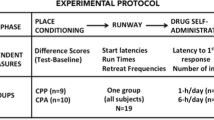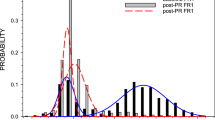Abstract
Rationale
We have previously described a model in which adult outbred male Sprague–Dawley rats are classified as either low or high cocaine responders (LCRs or HCRs, respectively) based on acute cocaine-induced open-field activation. This model revealed important individual differences in cocaine's effects, including that LCRs exhibited greater responding than HCRs on a progressive ratio schedule of cocaine reinforcement. However, no LCR/HCR differences in acquisition of cocaine self-administration (0.25 mg/kg/12 s infusion) were observed under these conditions.
Objectives
To determine if LCRs and HCRs differ in the effectiveness of cocaine to function as a reinforcer under a broader range of conditions, the present study assessed the acquisition of cocaine self-administration (fixed ratio 1 schedule of reinforcement) as a function of i.v. cocaine dose (0.1875, 0.375, 0.5, 1, or 1.5 mg/kg/6 s infusion).
Results
LCRs and HCRs did not differ significantly on any measure of acquisition examined, including the day to meet acquisition criterion, percent acquired, and cocaine intake. The effect of dose on percent acquired and rate of acquisition peaked at the 1-mg/kg/infusion dose of cocaine. In contrast, the effect of dose on cocaine intake was linear, with the highest rate of intake occurring at the 1.5-mg/kg/infusion dose of cocaine.
Conclusions
LCRs and HCRs do not appear to differ in their acquisition of cocaine-reinforced operant responding across a range of cocaine doses, including conditions that lead to high levels of cocaine intake.



Similar content being viewed by others
References
Allen RM, Everett CV, Nelson AM, Gulley JM, Zahniser NR (2007) Low and high locomotor responsiveness to cocaine predicts intravenous cocaine conditioned place preference in male Sprague–Dawley rats. Pharmacol Biochem Behav 86:37–44
Belin D, Mar AC, Dalley JW, Robbins TW, Everitt BJ (2008) High impulsivity predicts the switch to compulsive cocaine-taking. Science 320:1352–1355
Caine SB, Lintz R, Koob GF (1993) Intravenous drug self-administration techniques in animals. In: Sahgal A (ed) Behavioral neuroscience: a practical approach. Oxford University Press, Oxford, pp 117–143
Carroll ME, Lac ST (1997) Acquisition of i.v. amphetamine and cocaine self-administration in rats as a function of dose. Psychopharmacology (Berl) 129:206–214
Chen BT, Bowers MS, Martin M, Hopf FW, Guillory AM, Carelli RM, Chou JK, Bonci A (2008) Cocaine but not natural reward self-administration nor passive cocaine infusion produces persistent LTP in the VTA. Neuron 59:288–297
Corda MG, Piras G, Lecca D, Fernandez-Teruel A, Driscoll P, Giorgi O (2005) The psychogenetically selected Roman rat lines differ in the susceptibility to develop amphetamine sensitization. Behav Brain Res 157:147–156
Gawin FH (1991) Cocaine addiction: psychology and neurophysiology. Science 251:1580–1586
Gulley JM, Hoover BR, Larson GA, Zahniser NR (2003) Individual differences in cocaine-induced locomotor activity in rats: behavioral characteristics, cocaine pharmacokinetics, and the dopamine transporter. Neuropsychopharmacology 28:2089–2101
Homberg JR, van den Akker M, Raaso HS, Wardeh G, Binnekade R, Schoffelmeer AN, de Vries TJ (2002) Enhanced motivation to self-administer cocaine is predicted by self-grooming behaviour and relates to dopamine release in the rat medial prefrontal cortex and amygdala. Eur J Neurosci 15:1542–1550
Kamens HM, Burkhart-Kasch S, McKinnon CS, Li N, Reed C, Phillips TJ (2005) Sensitivity to psychostimulants in mice bred for high and low stimulation to methamphetamine. Genes Brain Behav 4:110–125
Lambert NM, McLeod M, Schenk S (2006) Subjective responses to initial experience with cocaine: an exploration of the incentive-sensitization theory of drug abuse. Addiction 101:713–725
Lecca D, Cacciapaglia F, Valentini V, Acquas E, Di Chiara G (2007) Differential neurochemical and behavioral adaptation to cocaine after response contingent and noncontingent exposure in the rat. Psychopharmacology (Berl) 191:653–667
Mandt BH, Schenk S, Zahniser NR, Allen RM (2008) Individual differences in cocaine-induced locomotor activity in male Sprague–Dawley rats and their acquisition of and motivation to self-administer cocaine. Psychopharmacology (Berl) 201:195–202
Mandt BH, Zahniser NR (2010) Low and high cocaine locomotor responding male Sprague–Dawley rats differ in rapid cocaine-induced regulation of striatal dopamine transporter function. Neuropharmacology 58:605–612
Mantsch JR, Ho A, Schlussman SD, Kreek MJ (2001) Predictable individual differences in the initiation of cocaine self-administration by rats under extended-access conditions are dose-dependent. Psychopharmacology (Berl) 157:31–39
Miguens M, Crespo JA, Del Olmo N, Higuera-Matas A, Montoya GL, Garcia-Lecumberri C, Ambrosio E (2008) Differential cocaine-induced modulation of glutamate and dopamine transporters after contingent and non-contingent administration. Neuropharmacology 55:771–779
Orona RA, Mayfield RD, Cline EJ, Zahniser NR (1994) Repeated intravenous cocaine administration to rats produces behavioral sensitization without changing brain cocaine levels. Neurosci Lett 167:121–124
Piazza PV, Deminiere JM, Le Moal M, Simon H (1989) Factors that predict individual vulnerability to amphetamine self-administration. Science 245:1511–1513
Piazza PV, Deroche-Gamonent V, Rouge-Pont F, Le Moal M (2000) Vertical shifts in self-administration dose-response functions predict a drug-vulnerable phenotype predisposed to addiction. J Neurosci 20:4226–4232
Sabeti J, Gerhardt GA, Zahniser NR (2002) Acute cocaine differentially alters accumbens and striatal dopamine clearance in low and high cocaine locomotor responders: behavioral and electrochemical recordings in freely moving rats. J Pharmacol Exp Ther 302:1201–1211
Sabeti J, Gerhardt GA, Zahniser NR (2003) Individual differences in cocaine-induced locomotor sensitization in low and high cocaine locomotor-responding rats are associated with differential inhibition of dopamine clearance in nucleus accumbens. J Pharmacol Exp Ther 305:180–190
Schenk S, Valadez A, McNamara C, House DT, Higley D, Bankson MG, Gibbs S, Horger BA (1993) Development and expression of sensitization to cocaine's reinforcing properties: role of NMDA receptors. Psychopharmacology (Berl) 111:332–338
Schramm-Sapyta NL, Cauley MC, Stangl DK, Glowacz S, Stepp KA, Levin ED, Kuhn CM (2011) Role of individual and developmental differences in voluntary cocaine intake in rats. Psychopharmacology (Berl) 215(3):493–504
Stead JD, Clinton S, Neal C, Schneider J, Jama A, Miller S, Vazquez DM, Watson SJ, Akil H (2006) Selective breeding for divergence in novelty-seeking traits: heritability and enrichment in spontaneous anxiety-related behaviors. Behav Genet 36:697–712
Thomsen M, Caine SB (2005) Chronic intravenous drug self-administration in rats and mice. Curr Protoc Neurosci Chapter 9: Unit 9.20
Zapata A, Chefer VI, Ator R, Shippenberg TS, Rocha BA (2003) Behavioural sensitization and enhanced dopamine response in the nucleus accumbens after intravenous cocaine self-administration in mice. Eur J Neurosci 17:590–596
Acknowledgment
This work and the authors were supported by NIH Grants R01 DA004216 and K05 DA015050. We would like to thank Emily Gomez, Jillian Laggart, Kari Massar, Merissa Pickell, and Alyssa Schickedanz for their dedicated help with data collection.
Conflict of interest
The authors have no conflict of interest to disclose.
Author information
Authors and Affiliations
Corresponding author
Additional information
An erratum to this article can be found at http://dx.doi.org/10.1007/s00213-012-2669-1.
Rights and permissions
About this article
Cite this article
Mandt, B.H., Johnston, N.L., Zahniser, N.R. et al. Acquisition of cocaine self-administration in male Sprague–Dawley rats: effects of cocaine dose but not initial locomotor response to cocaine. Psychopharmacology 219, 1089–1097 (2012). https://doi.org/10.1007/s00213-011-2438-6
Received:
Accepted:
Published:
Issue Date:
DOI: https://doi.org/10.1007/s00213-011-2438-6




